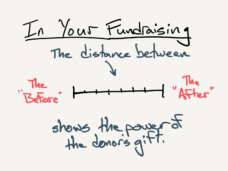Fundraising shouldn’t be all good news, and it shouldn’t be all bad news.
Your stream of fundraising communications should feature both.
Asking for gifts (appeals, e-appeals) works best when it shares the bad news: the problem or negative situation that your organization works on. That truth about what’s happening reveals the tension donors hold between what the world is like today and what they want the world to be.
That tension causes a lot of people to donate.
Reporting (newsletters) works best when it shares the good news: examples of how your organization made a difference. It brings real joy to donors to see the triumphs that their gift made possible – and many will want to give again to do more good and feel more joy.
Those triumphs will also cause people to donate.
Rules To Live By
Here’s what we’ve noticed…
If you share only bad news, you’ll raise less than you could raise. When we serve organizations who previously only shared the bad news, they raise more money when they incorporate Reports that share the good news.
If you share only good news, you’ll raise less than you could raise. When we serve organizations who previously only shared the good news, they raise more money when their appeals and e-appeals share the problem or negative situation their organization works on.
Finally, in the context of direct response fundraising, each piece of communication should focus on only one type of news. When we’ve served organizations who previously “mixed together” the good news and bad news in each piece of fundraising, they raise more money when their appeals and e-appeals share the bad news, and their newsletters share the good news.
We wish it weren’t that way, because it means that organizations must share tough needs and tough stories. And they must be disciplined about what they put in each piece of communication. But this approach helps the organizations we serve to raise a great deal more money.
Steven Screen is Co-Founder of The Better Fundraising Company and lead author of its blog. With over 30 years' fundraising experience, he gets energized by helping organizations understand how they can raise more money. He’s a second-generation fundraiser, a past winner of the Direct Mail Package of the Year, and data-driven.









One comment on “Not All Good, Not All Bad”